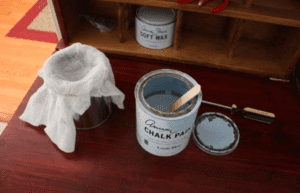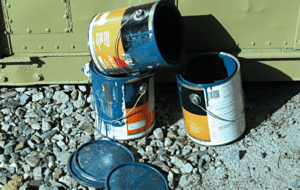Most people are concerned about their pipes and faucets during winter. When freezing occurs, rarely do you think of your stored paint. However, freezing can also affect stored paint. Freezing affects the smooth consistency of paint, making it difficult to use.
So, can paint be used after it freezes? Yes, you can still use the paint, but first, you must restore it. Restoring the paint is done by thawing it at room temperatures outside. Gradual thawing is the best way to restore the paint and restore the paint’s consistency.
In this post, I’ll discuss what happens when paint freezes, how to restore it, and share some paint storage tips.
What does paint contain?
Before digging deep into why paint freezes and how to restore it, let’s first see what paint contains. Below are some essential components of paint.
Pigment: This is the main ingredient and what gives the paint its color.
Binders: Next, you’ll find binders which are the main ingredients in types of paints. Binders hold the paint pigments together. They also ensure the paint adheres to the application surfaces.
Liquid: Paint also contains liquids that allow for seamless paint application. The liquid also holds some solid components of the paint. Evaporation of the liquid components makes the paint dry after application.
The two common liquids in paints are oil and water. There are usually two types of paint based on the liquid used. These are water-based paint and oil-based paint.
Additives: There are also additives that constitute a small part of the paint. Additives alter various paint properties. They can make the paint resistant to water and allow for faster drying.
What makes paints freeze?
Three factors determine how fast the paint freezes? These factors are the type of paint (water-based or oil-based), temperatures, and where you store the oil. Let’s look at the factors closely.
Water-based vs. oil-based at freezing temperatures
Oil-based oils are more resistant to freezing. They begin to freeze at very cold temperatures of -4 degrees F. Water-based oils, on the other hand, start freezing at water temperatures. Water freezes at 32 degrees F, where water-based paints will start to freeze.
Persons living in warmer regions of the world will never worry about oil-based paints ever freezing. For water-based paints, the amount of water also determines how fast the paint freezes.
The paint will freeze depending on the water quantity on the paint. Paints with less water as a liquid take longer to freeze.
Temperatures
The exact temperatures in your area also determine how fast paints freeze. For example, water-based oils will start freezing slowly at 32 degrees F. However, at 20 degrees F, the paint will freeze faster.
Storage conditions
Lastly, how you store your paint can determine the freezing speed. Paint exposed to weather elements will freeze faster as opposed to sealed paint.
It is crucial you understand the freezing point of each paint and store them at appropriate temperatures.
What Happens to Paint When It Freezes
The paint gets hard and solid. This is the same thing that happens to water when it freezes. Water-based paints like latex are the most susceptible to freezing. The paint will start freezing at 32 degrees F.
As the paint freezes, its emulsion is affected. In addition, the paint’s consistency and texture get affected. This makes it pretty hard to spray or apply the paint on a surface.
You need to restore the paint and return the consistency before using the paint again. It is easier to thaw paint that has frozen for a short period than one that remains solid all year.
How to Restore Frozen Paint

Before you throw away the frozen paint, you need to assess whether it can be restored. Is the consistency completely off? Follow the steps below to restore the oil.
Thaw the Paint
The first thing you need to do is allow the paint to thaw. Thawing the paint is done indoors at room temperatures. The best way to do it is to let the paint thaw naturally.
Resist the urge to use a space heater, fan, or any source of heat. Getting the paint more heat will further alter its composition and damage it further.
Thawing might take several hours, depending on the amount of paint. Place old newspapers under the paint to protect the floor in case paint spills over.
Assess thawed paints for lumps
Once the paint is thawed, you need to assess it for usability. There are no guarantees the paint will be restored and reused. If the paint was frozen for a long period, it might be unusable. However, if it was partially frozen for a short period, thawing will make it appear normal.
Look for little lamps in the paint that appear like cottage cheese. You can pour the paint into a new container and separate the clumps.
If there are several clumps, then the paint is unusable. However, before you can throw away the paint, there is one thing you can do.
Stir the frozen paint
If there are clumps after the paint has thawed, try and stir it vigorously. You can use a motor-powered mixer or stir by hand using a stick.
Stirring takes time, and one must be patient. Depending on the number of clumps, stirring might work or not work.
Try and strain large lumps from your paint using a strainer. While the paint might not return to its original status, it can be used for outdoor projects.
Test the thawed paint
Lastly, you can test the paint for usability in an inconspicuous area. You don’t want frozen paint on an important project without testing it.
Look for scrap wood pieces and try the paint there. Where do you plan to use the paint? Look for a similar surface and test the paint there. Testing the paint is important to avoid a complete disaster at work.
Even when the paint seems fine, avoid using it on important indoor projects. Restored paint can be used on outdoor projects that are not very important. You can watch the video below on how to restore frozen latex paint. https://www.youtube.com/watch?v=qImlM1ECqp0
Paint Storage Tips to Prevent Freezing

How you store the paint can prevent freezing and ensure paint lasts longer. Paint needs to be stored in cool areas with a heat source to prevent freezing. This is crucial, especially in the cold winter seasons.
However, this might not be possible if you have several paint cans. Furthermore, paints produce fumes and can be messy in rooms. Below are some tips to prevent paint freezing.
Use Paint Before Winter
Why store the paint throughout the winter season? Instead, consider using it before winter. This will take away the headache of storage and get your project done early.
I have a tendency to postpone small projects. If you’re like me, then it’s time you got to work and finish your project before winter kicks in.
Using old paint before winter can save you the storage hassles and costs of buying new paints. Repaint old sheds, indoor walls, and other projects instead of storing the paint.
Heat the Storage Area
If you’re storing paint in a garage, then install a heat source. Get a space-heater and a thermometer in the garage to monitor the temperatures. If you’re storing latex oil, make sure the temperatures don’t drop below 32 degrees F.
Create a Warm Paint Box or Shelf
You can also build a painted box or shelf and place it in the garage. A heated paint box is easy to build using heat tape, a lamp, and some insulation. Make the box spacious to fit your paints and the bulb.
How to Dispose of Frozen Paint
If the paint is frozen for long periods and cannot be restored, you need to dispose of it. Open the paint can and let the paint dry out. Once dry, you can throw the can into the trash can.
You can also mix the paint with sawdust and let it dry. Make sure you follow local guidelines on how to dispose of old paint. You don’t want to contribute to environmental pollution.

